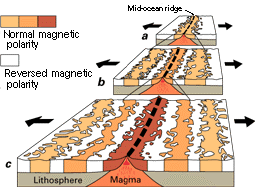|
The Theory of Plate Tectonics (2) Magnetic Striping and Polar Reversals  | | Figure source: http://pubs.usgs.gov/publications/text/developing.html |
Research for magnetic striping and polar reversals began after World War II, when scientists, using magnetometers, towed behind ships began to recognize odd magnetic variations on the ocean floor. Although this was the first time data of this sort had been recorded, it was not totally surprising. The ocean floor is made up of an iron-rich, volcanic rock called Basalt. Within this rock is a strongly magnetic mineral called Magnetite, which has been know to locally distort compass readings. As more maps were made, scientists revealed a zebra-like pattern on the ocean floor of rocks with either normal or reversed magnetic polarity.
As the Basalt flows out of a mid-ocean ridge to form new ocean floor, the magnetite within the Basalt behaves like little magnets that during cooling align themselves in the direction of the Earth's magnetic field and become solidified this way. Normal polarity is defined as the magnetic minerals in the rock having the same polarity as the Earth's present magnetic field (i.e. the north end of the rock's "compass needle" is pointing in the same direction as Earth's current magnetic north). In contrast, reversed polarity is defined as the magnetic minerals in the rock having opposite polarity to the Earth's present magnetic field (i.e. the north end of the rock's "compass needle" is pointing south). The zebra-like pattern is the result of the normal and reversed polarities formed one after one another during sea-floor spreading. Scientists do not fully understand how the Earth's magnetic field switches polarity.
|







